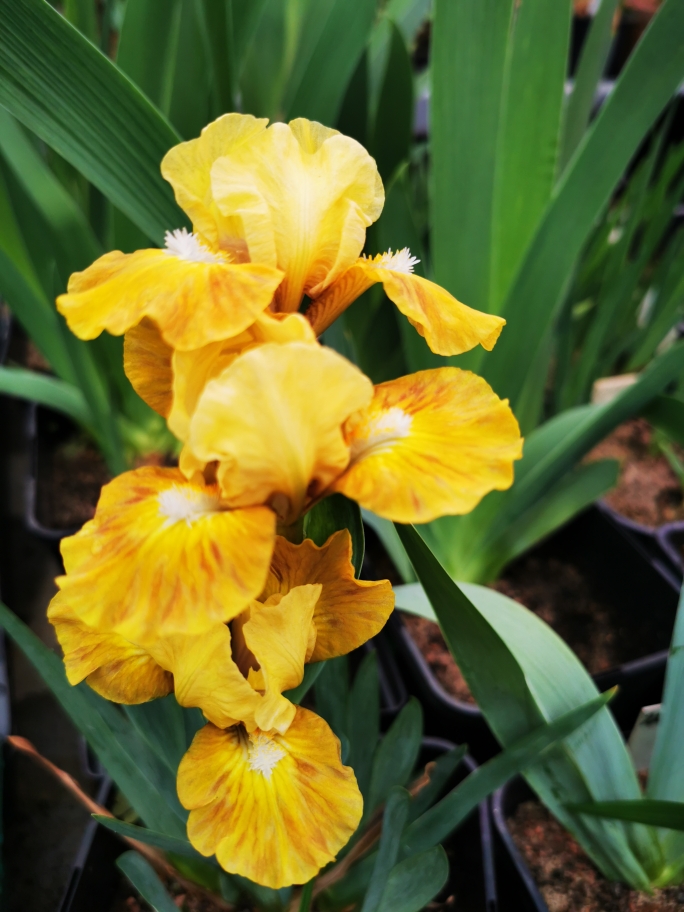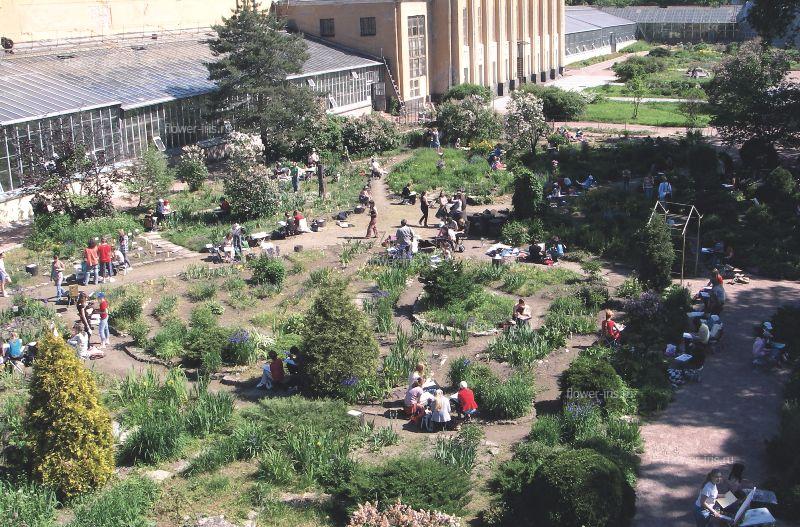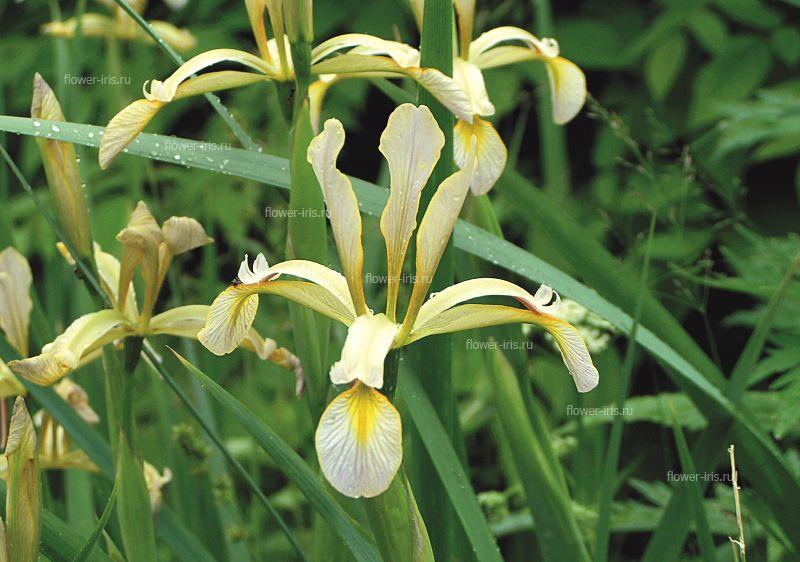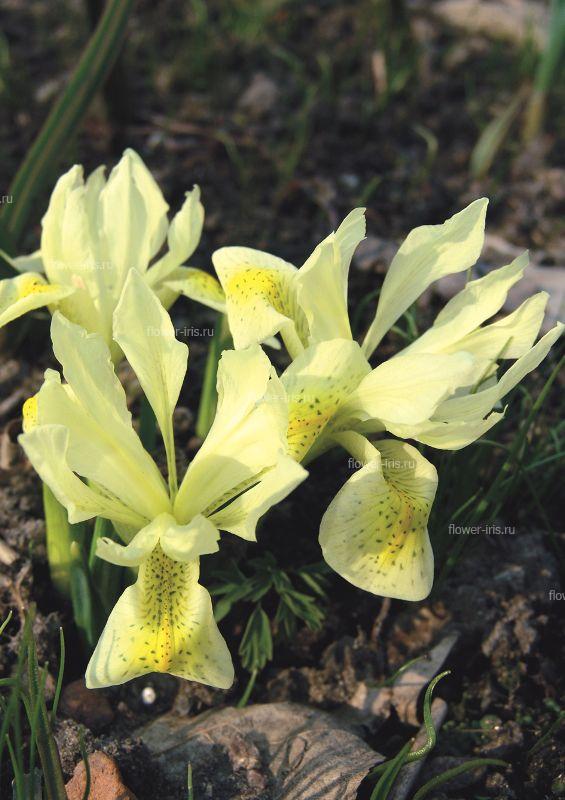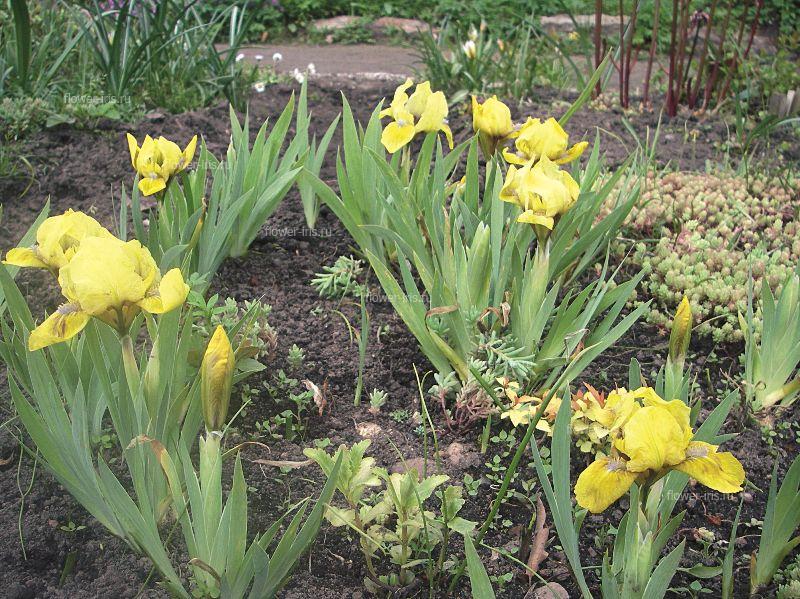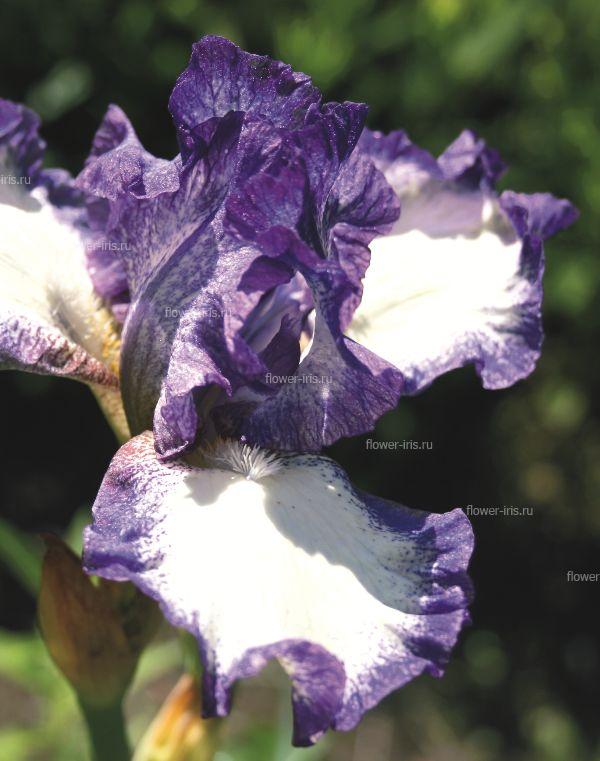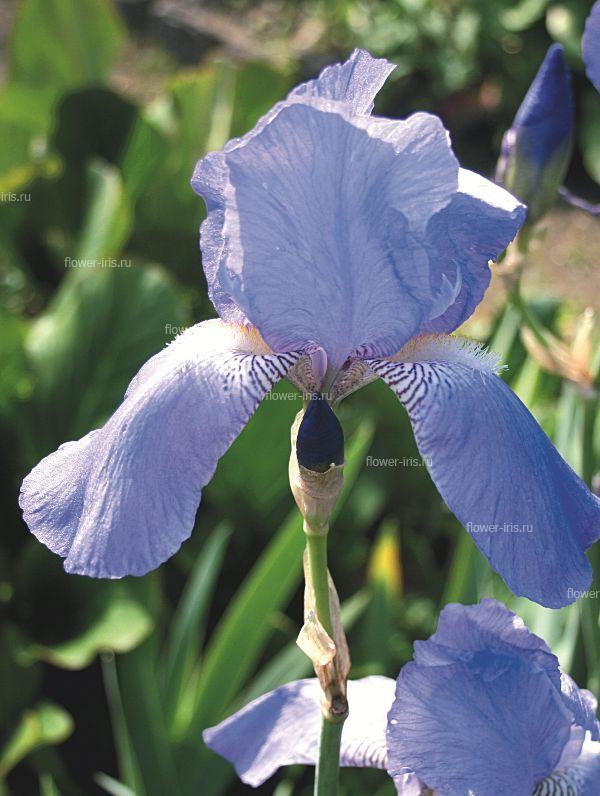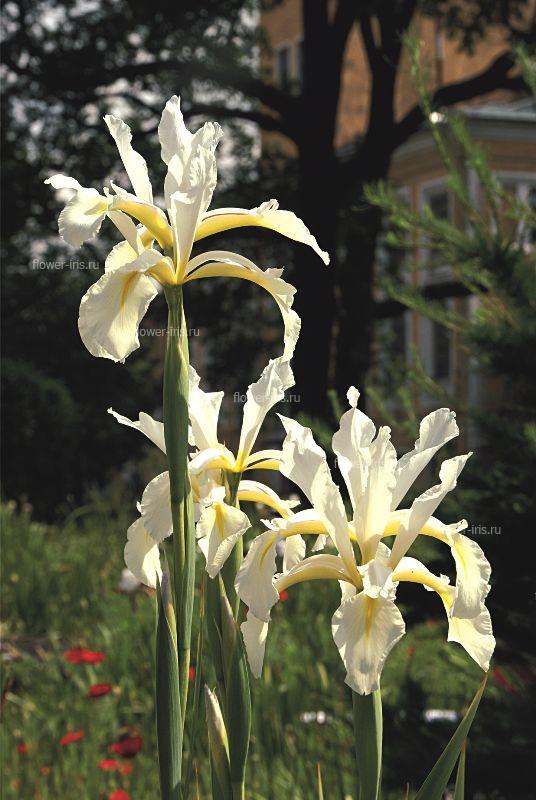|
News Photo Gallery |
Genus IrisHomepage → Books on Iridarium (Iris Garden) → Look in the book → Genus Iris
Introduction
Create iridariya Family Iridaceae Bulbotubers Bulbous Rhizomatous Genus Iris Subgenus Iris Subgenus Limniris Subgenus Eremiris Subgenus Xyridion Subgenus Tenuifolia Genus Pardanthopsis The exhibition "Iris Russia" Exposure Iris garden Cultivate Insect Pests and diseases of Irises Literature The translation is done through the service translate.google.com. Genus Iris, and Iris (Iris), - at all times is very popular. Species of the genus (up to 200 names) have a wide range, covering most of the Northern Hemisphere: Europe, Asia, North America, North Africa. A characteristic feature of the genus is the shape of a flower - namely, its two-tier structure of the three inner, most species are raised, shares and three outer perianth lobes, bent down. Currently, the standard system for the genus Iris does not exist. Many systematics believe that the similarity of flower structure is used? Lshee important than the difference between the groups in the vegetative characteristics of root system and leaves. They understand the genus Iris in a broad sense, that is, along with the rhizomatous species they include gender and bulbous irises. Other authors excluded from this kind of bulb types, moreover, recently renewed trend of isolation and rhizomatous species of the genus Iris (Mavrodiev, Alekseev, 2003; Rodionenko, 2005, 2006, 2007). In this paper, we take the genus Iris only in the rhizomatous species (without releasing birth Cryptobasis Nevski, Xyridion (Tausch) Fourr., Limniris (Tausch) Reichenb., Eremiris (Spach) Rodionenko) and distribute it to the seven subgenera: Iris (Iris) , Krossiris (Crossiris), Ksiridion (Xyridion), Limniris (Limniris), Nepalenzis (Nepalensis), Tenuifoliya (Tenuifolia), Eremiris (Eremiris). Genus Iris - perennial herb with a rhizome, or buried in soil at the surface, and the sword-shaped leaf blades. Flowers solitary or in inflorescences at the base covered 1.3 involucral bracts, with more or less pronounced tube perianth and six-membered limb; lobes consist of a narrow claw, gradually or immediately rolling in a wide plate, 3 internal share sometimes completely undeveloped, outdoor share lowered down. Fruit from iris - polyspermous, oblong box. Seeds flattened, rounded or pear-shaped, sometimes slightly winged or prisemyannikom. Irises are propagated mainly by dividing rhizomes. In Russia grows 40 kinds of iris. They are found in practically all regions of Russia. Most of the species is common in the south of the boreal region, Middle Eastern and East Asian regions. The area covers the kind of even part of the Siberian Subarctic. But the variety of iris in different regions of Russia are very different. Areas of the three Caucasian types - because fake (I. notha), because lozhnonenastoyaschy (I. pseudonotha) and K. Timofeev (I. timofejewii) - do not go beyond the borders of Russia. Small fragments of the northern areas are found in the territory of the Russian Caucasus, these include: k ostrodolny (I. acutiloba), because Colchis (I. colchica), K. Klatt (I. klattii), because Pontiac (I. pontica); in Western Siberia - k Kamelina (I. kamelinii), Ludwig (I. ludwigii); in Tuva - because Lochan (I. loczyi), because psammokola (I. psammocola); in the Far East - k Maak (I. maackii), because ostrolepestny (I. oxypetala), because Vorobyov (I. vorobievii), because Manchu (I. mandshurica). Species such as - Ludwig, K. Maak, because Pontiac, k and k Vorobyov Kamelina outside Russia are also very rare and little known. Common species of the European part of Russia and the Russian Caucasus are of the subgenus Iris K. and K. leafless dwarf. This group also includes another closely related species - because skinny - Caspian endemic (present area - the lower river. Volga and Eastern Caucasia). Appearance is timed to Solonetzic substrates and sand. Extensive ranges are low because, since the dwarf, because of Siberia, but these areas of non-continuous, and in many areas these species can be attributed to rare. Some species with large ranges, including outside Russia, are fairly common (k xiphoid, room Potanin, because yellow, because Russian on board, bristle, because single-flowered). Some species with wide distribution outside of Russia, only the edge of its range, go to the territory of the country (because ostrodolny, because milk-white, because Lochan, K. Vorobyev, because Kamelina, room psammokola). Iris species have mastered a wide range of habitats - from coastal to desert, climbing up to the high mountains that prefer open spaces and especially warm areas. Some species growing in forest clearings and edges, can come and sparse forest areas - because leafless (I. aphylla), because Bludova (I. bloudowii), since Russian (I. ruthenica), because single-flowered (I . uniflora). A number of iris confined to the meadows of different types - both lowland and highland. Mainly distributed in Russia steppe and semi-desert species - because fake (I. notha), because dwarf (I. pumila), since fine-leaved (I. tenuifolia) and swollen because (I. ventricosa). K. leathery (I. scariosa) - characteristic plant stony dry steppes. K. Kamelina (I. kamelinii), since Potanin (I. potaninii) and K. Brindle (I. tigridia) - mountain-steppe and alpine (alpine) types, which cover the southern slopes of the mountains at an altitude of 3500 m above sea level. m Significant difference in vegetation Russia have since solelyubivy (I. halophila), since low (I. humilis), since the Siberian (I. sibirica) and K. Russian (I. ruthenica). K. yellow (I. pseudacorus) and k bristle (I. setosa) - highly visible landscape plants that make large bright green curtains and strips along rivers, streams and springs, and K. Klatt (I. klattii), to . xiphoid (I. ensata) and k smooth (I. laevigata) grow well in open, well-lit, alternately waterlogged areas and marshy meadows. Ecologically, species diverse. Among them are psammophytes, for example, since fine-leaved (I. tenuifolia), characterized by high heat-and drought-resistant, and hydrophytes - k and k smooth yellow and kaltsefily - Ivanov (I. ivanovae), since Tiger (I. tigridia), because bluish (I. glaucescens), and kaltsefoby - k and k xiphoid blood red (I. sanguinea). There are species that can tolerate the high salinity of the soil - because milk-white (I. lactea), and, finally, the views and outstanding high cold resistance, for example, room bristle (I. setosa), leaving the Arctic Circle, that is, on the other representatives Iridaceae. Exquisite flower iris has a very rich range of colors. However, most species growing in Russia is mostly blue color of different shades of blue - k bristle and dark purple - because blood red, because fork (I. furcata) to yellow - solelyubivy k, k Potanin. Flowers of many species have dark veins at the base of the perianth shares or around petal - k Bludova, room Kamelina, since low, because mackerel. Without changing the overall color of the flower, they make them more visible to insects and may moderate the effects of solar radiation. Some iris have a pleasant aroma (since Russian). Pollination of the genus Iris is a variety of ways - at least for specialized in entomophilous (insect-pollinated) flowers iris possible autogamy (selfing) - C. bristle, because marsh, many other species of the subgenus Limniris (Limniris). Slabospetsializirovannaya and mainstream entomophily occurs in species with accessible nectar, for example, the species of the subgenus Eremiris (Eremiris), as well as the species of the subgenus Ksiridion (Xyridion). Entomophily are highly specialized species of the subgenus Iris (Iris), characterized by the presence of barbs multicellular hairs on the outer perianth lobes, the appearance of which is likely to happen in the specialization of the flower on pollination by insects. The resumption of the genus Iris populations is due to seed and vegetative propagation. Iris seeds can be spread by water, wind, ants, birds and various animals. Thus, the distribution of seeds and fruits of most species of the subgenus Limniris happens with water. They nonwetting epidermis and pneumatic cavities. There are species that are distributed ballistic seed dispersal, ie species which boxes to erect stems crack at the top and fall on the ground only when swinging. So spread easily because in bristle and winged seeds because of the Siberian. Types of sections Onkotsiklyus (Oncocyclus), and Psammiris (Psammiris), the seed of which develops a fleshy appendage, distributed, probably ants. Vegetative propagation is due to iris rhizomes. Species of the genus Iris has long introduced to the culture (including selection) as lovely ornamental plants that adorn the gardens, parks and many of the natural landscape. They have all the arts - and the sword-shaped leaves and stems, with flowers in summer and autumn fruits. Iris flower has a very rich range of color shades. Most species suitable for cutting, forcing, curb and group plantings, borders edges. Species with tiny leaves and peduncles short on spectacular rock gardens - because dwarf (I. pumila), since Russian (I. ruthenica). Species of lowland wetland habitat suitable for decorating ponds - k smooth (I. laevigata), because yellow, or marsh (I. pseudacorus). Beautiful iris blossoms were not the only reason why they came to the attention of man. Since ancient times, people turned to these plants for medicinal purposes. Iris was used as a wound-healing agent in gastric and intestinal disorders, as an antibacterial agent, as well as to alleviate the cough. A piece of rhizome given to children to relieve toothache. Observations of recent years have shown that some species are widely used in folk medicine in the form of decoctions and infusions. Some iris have a nice flavor, but flavor is not particularly valuable flowers, and roots that have been used in perfumes, - k Florentine (I. florentina) and k pale (I. pallida). They were transported over long distances, as can long persist without soil. Many species of Iris widely used as industrial raw material. Some species suitable for weaving ropes, mats, rugs. In addition, they can be used as natural dyes. Of 7 subgenera iris collection Iridariya no representatives of the subgenus Nepalenzis (Nepalensis) - Nepalese iris. Types, and their 4 are found in the mountainous regions of India, China, Nepal, Thailand. We know that in England because comely plants (I. decora) are grown in the winter keeping the rhizomes indoors. Another species of the subgenus - Krossiris (Crossiris) - Fringed iris - in the north can be grown only in a greenhouse or as houseplants. The representatives of the subgenus in the central vein external perianth shares have a crest. They grow in subtropical areas of Japan, China and North America. Subgenus includes 10 species. The collection of many years of cultivated three species since Comb (I. cristata), because roofing (I. tectorum) and because Japanese (I. japonica) - It is an evergreen ground cover perennials with beautiful dense foliage. I. cristata Soland. - K. comb. Miniature plant, green rhizome, creeping, branched, with slender branches. Image of a beautiful leafy curtain. The leaves are light green, shirokomechevidnye, gradually tapered to the ends. Stems 10-12 cm tall., Single-flowered. The flowers are 5-6 cm in diameter, wide open, palely pink-blue. It grows on river sediments and slopes warm temperate and subtropical zones of the southeastern United States. It flowers in May and June. Fruiting in August. I. japonica Thunb. - K. Japanese. Rhizome green, creeping, branched, with thin branches (stolons), without significant annual swelling grew into powerful curtain. The leaves are drooping, smooth, shiny on the outside, bottom mat. Stems 35-45 cm tall., On top of richly branched, many-flowered, 15-19 (25) flowers. The flowers are small, 3-5 cm in diameter., No flavor or aroma with a very weak, pale purple, wide open. Inner perianth lobes almost horizontally outstretched, on the edge melkobahromchatye. Native to China and Japan in the wet mountain meadows, with adequate moisture (flow humidification) rocky slopes, on the edge of the forest, on the open plains of the plateau at an altitude of 3000-3300 meters above sea level. m flowers in May and June. Fruiting in August. I. tectorum Maxim. - K. roofing. Rhizome creeping, relatively thick. Shirokomechevidnye leaves, light green. Stems 35-45 cm high. Flowers are large, 7-9 cm in diameter., Violet-purple, with large bright fringed ridge on the outer perianth lobes. It is widely distributed in China and Japan. It grows in open sunny places, on the edge of the forest, in wet soil. Blooms in late May. Fruit in July and August. Most rhizomatous iris can be grown in the open field. Need a lot of time and attention to the care, but when the plants bloom - they justify this concern. They will enchant you with its beauty, will give a real treat every time revealing something elegant, unusual and mysterious. The following is a morphological description of the subgenera, sections, and those species that have been tested on Iridarii for many years, and raised in the present and can be recommended for a wide range of garden enthusiasts and professionals of this mnogoletnika. |


 Eng
Eng

